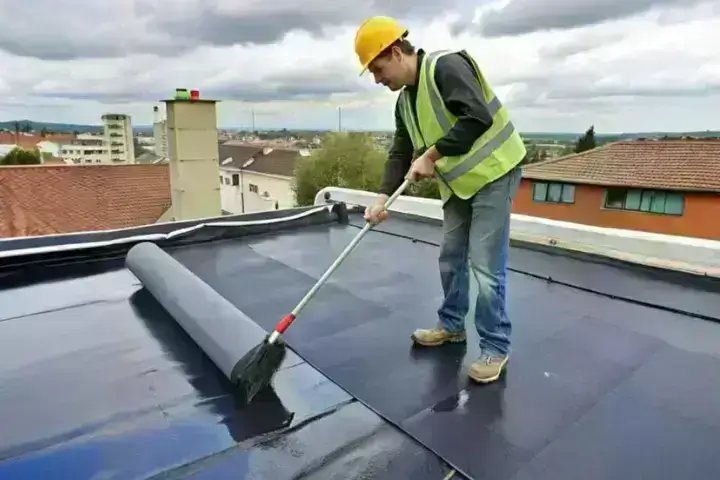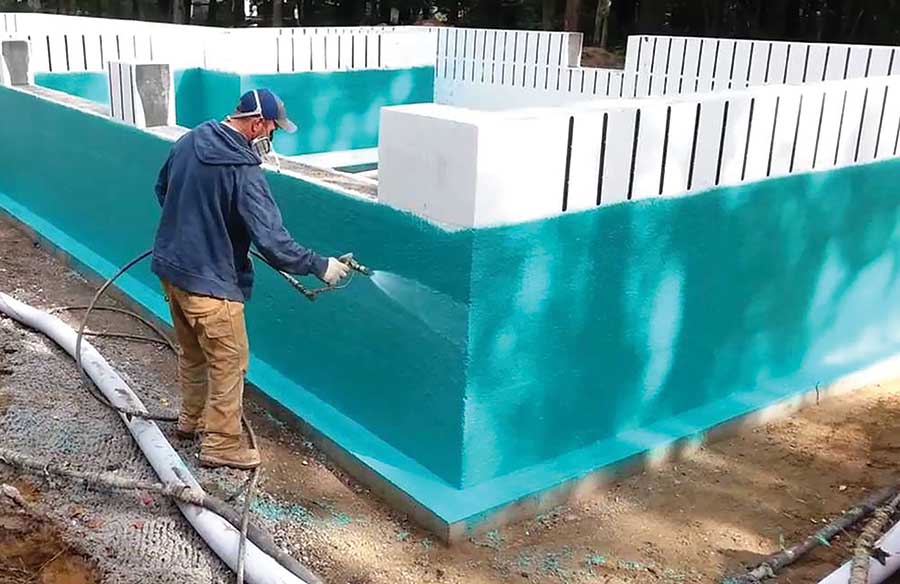Exactly How Waterproofing Works: A Thorough Check Out Techniques and Technologies
Waterproofing is important for protecting frameworks from moisture-related damage. It entails different techniques and modern technologies that produce obstacles against water breach. Standard methods, such as compressed clay, coexist with modern-day advancements like liquid-applied membrane layers. Comprehending the nuances of these techniques is vital for efficient application. However, the performance of any waterproofing option hinges not only on the strategies utilized yet also on continuous upkeep and evaluation. What are the vital factors that influence long-term efficiency?
Understanding the Fundamentals of Waterproofing
Waterproofing is an essential process that secures frameworks from water intrusion, which can lead to considerable damages over time. This method includes the application of different products and strategies designed to produce a barrier against wetness. The key objective is to stop water from penetrating surfaces, which can trigger degeneration, mold and mildew development, and architectural instability.Various factors influence the choice of waterproofing method, including the type of structure, its place, and environmental conditions. Comprehending the physics of water motion and the buildings of various products is essential in selecting a reliable waterproofing solution.Effective waterproofing not just safeguards structures yet additionally boosts their long life and stability. Normally, it is incorporated into the design phase of construction to assure complete defense. As awareness of water-related problems grows, the importance of understanding waterproofing fundamentals ends up being progressively clear to engineers, contractors, and residential property proprietors alike.
Traditional Waterproofing Approaches
Standard waterproofing techniques have been made use of for centuries, relying upon tried and true techniques and products to secure structures from water damage. Among the oldest approaches includes the use of clay, which, when compressed, produces a natural obstacle against dampness. Furthermore, bitumen, a sticky, black product originated from oil, has been used for its water-resistant residential or commercial properties, frequently put on roofings and foundations.Another technique includes the application of lime-based plasters, which provide a breathable layer that permits moisture to run away while avoiding water access. Thatch roof, a typical technique still seen in some societies, provides superb waterproofing because of its snugly packed straw layers.Moreover, making use of stone and brick has actually been popular, as these products are inherently resistant to water when effectively installed. Generally, traditional waterproofing techniques stress the significance of choosing ideal materials and building techniques to enhance toughness against water invasion.
Modern Waterproofing Technologies
Innovations in modern waterproofing innovations have actually changed the way structures are secured from water damages. Cutting-edge approaches such as liquid-applied membranes and sophisticated sealers have actually enhanced the effectiveness and flexibility of waterproofing remedies. These modern technologies allow for smooth application, lowering the threat of leakages and ensuring thorough protection over intricate surfaces.Moreover, the integration of smart innovations, such as wetness sensors and automated tracking systems, allows real-time analysis of waterproofing efficiency. This positive technique promotes prompt upkeep and minimizes long-lasting repair service costs.Additionally, innovations in spray-applied layers supply fast application and superb attachment, adjusting to different substrates while providing robust defense. Strategies like polymer-modified systems better improve versatility and sturdiness, making them ideal for varied settings. Generally, contemporary waterproofing innovations not only minimize water breach however also contribute to the long life and sustainability of frameworks, marking a significant change in the market.
Materials Made Use Of in Waterproofing
The efficiency of waterproofing services greatly depends on the materials made use of in their application. Different products are utilized to create obstacles against water access, each with distinct residential properties suited for various atmospheres. Commonly utilized materials consist of membranes, finishes, and sealants.Liquid-applied membranes, usually made from polyurethane or acrylic, develop a smooth barrier that adjusts to complex surface areas. Sheet membranes, normally constructed from rubber or polycarbonate, offer sturdiness and are perfect for bigger locations. Furthermore, cementitious waterproofing products, composed of cementitious compounds, give outstanding bond and flexibility.Sealants made from silicone or polyurethane are crucial for joints and seams, making sure detailed defense. Sophisticated products, such as geo-composite membranes, integrate numerous functions, improving performance. Overall, the option of waterproofing products is vital in achieving resilient and efficient water resistance, customized to certain task needs and ecological problems.
Typical Applications of Waterproofing
Waterproofing plays a vital duty in numerous markets, making sure the long life and stability of frameworks. Usual applications consist of household options that secure homes, industrial facilities that safeguards businesses, and commercial settings that need robust security versus dampness. Comprehending these applications highlights the importance of waterproofing in maintaining both safety and security and functionality across various settings.
Residential Waterproofing Solutions
Numerous property owners face obstacles with dampness breach, making efficient domestic waterproofing remedies essential. Different methods exist to resolve this concern, including interior and exterior waterproofing systems. Inside services commonly entail the application of sealers and coatings to cellar walls, which assist stop water seepage. Exterior approaches usually include the installation of water drainage systems and water-proof membrane layers that divert water far from the foundation.Additionally, home owners may take into consideration sump pumps to get rid of water accumulation and dehumidifiers to manage humidity levels. Appropriate grading and making use of seamless gutters additionally play a vital function in managing water circulation around the home. By implementing these methods, homeowners can substantially lower the threat of Website water damages and mold development, ensuring a completely dry and risk-free living atmosphere.

Commercial Framework Security
Efficient waterproofing services play a critical duty in the security of industrial infrastructure. Foundation waterproofing Omaha. These methods are vital for protecting buildings, parking frameworks, and bridges from water damages, which can compromise structural stability and lead to costly repair work. Typical applications include the installation of membrane layers, coverings, and sealants that develop barriers against wetness infiltration. Locations such as cellars, roof coverings, and outside wall surfaces are often focused on to ensure longevity and sturdiness. Furthermore, waterproofing systems can enhance power effectiveness by preventing water-related issues that might cause mold growth and wear and tear. By applying durable waterproofing steps, homeowner can secure their financial investments and keep functional efficiency, ultimately adding to the total sustainability of industrial centers
Industrial Applications Summary
While various industries face special obstacles, the requirement for dependable waterproofing services continues to be a continuous in commercial applications. Industries such as production, building, and power usually come across settings where moisture exposure can jeopardize architectural integrity and functional performance. In producing centers, waterproofing is vital for shielding equipment and materials from water damages. In construction, it safeguards structures and cellars against groundwater seepage. The power field relies on waterproofing for the security of tools in hydroelectric plants and offshore structures. Additionally, food processing industries utilize waterproofing to assure health and compliance with security standards. Overall, efficient waterproofing options are essential for enhancing toughness, safety, and performance throughout numerous commercial settings.
Maintenance and Longevity of Waterproofing Solutions
Although waterproofing options are made to use long-term security against dampness invasion, normal upkeep is necessary to guarantee their performance and longevity - Water Solutions. Regular evaluations play a considerable role in identifying prospective issues kerdi waterproofing such as cracks, peeling, or indications of water damage. Dealing with these troubles quickly can stop further damage and expensive repairs.Additionally, cleaning the surface area of waterproofed locations assists get rid of dust and debris that could compromise the stability of the waterproofing obstacle. It's also recommended to reapply safety coatings or sealants as suggested by suppliers to maintain perfect performance. Ecological variables, such as UV direct exposure and extreme climate condition, can impact the life-span of waterproofing products, making normal assessment vital
Often Asked Concerns
Can Waterproofing Be Applied in Winter?
The inquiry of using waterproofing in winter elevates concerns about adhesion and curing. Many products may not perform at their best in low temperatures, necessitating careful option and factor to consider of details standards for reliable application.
Just How Long Does Waterproofing Generally Last?
The duration of waterproofing effectiveness differs based upon products and ecological elements. Typically, it check that can last from five to ten years, yet normal maintenance and evaluations are necessary to ensure peak performance and long life.
Is Do It Yourself Waterproofing Effective and Safe?
The efficiency and security of DIY waterproofing rely on numerous elements, including worldly high quality and application method. While some individuals attain sufficient outcomes, others may run into problems that jeopardize long-term defense and structural integrity.
What Are the Indicators of Failing Waterproofing?
Indications of failing waterproofing consist of visible water discolorations, peeling paint, mold and mildew development, musty smells, and moisture in wall surfaces or ceilings - Sump pump discharge drainage Omaha. These indicators recommend compromised obstacles, necessitating punctual evaluation and possible remediation to avoid additional damage
Exactly how Do I Select the Right Waterproofing Service Provider?
